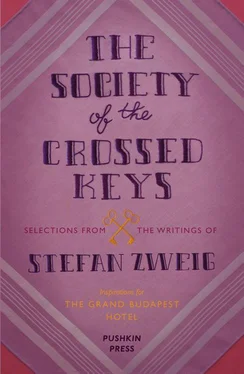What opportunities were open to a young man of the bourgeois world? In all other classes of society, including the so-called lower classes, the problem was not a problem at all. In the country, a farm labourer of seventeen would be sleeping with a maidservant, and if there were consequences of the relationship it was not so very important. In most of our Alpine villages the numbers of illegitimate children far exceeded those born in wedlock. In the urban proletariat, again, a young working man would ‘live in sin’ with a woman of his class when he could not afford to get married yet. Among the Orthodox Jews of Galicia, a young man of seventeen who had only just reached sexual maturity was given a bride, and he could be a grandfather by the time he was forty. Only in our bourgeois society was the real solution to the problem, early marriage, frowned upon, because no paterfamilias would have entrusted his daughter to a young man of twenty-two or twenty. Someone so young was not thought mature enough. Here again we can detect dishonesty, for the bourgeois calendar was by no means synchronised with the rhythms of nature. While nature brings a young man to sexual maturity at sixteen or seventeen, in the society of that time he was of marriageable status only when he had a ‘position in society’, and that was unlikely to be before he was twenty-five or twenty-six. So there was an artificial interval of six, eight or ten years between real sexual maturity and society’s idea of it, and in that interval the young man had to fend for himself in his private affairs or ‘adventures’.
Not that he was given too many opportunities for them at that time. Only a very few and especially rich young men could afford the luxury of keeping a mistress, meaning renting an apartment for her and providing for her keep. Similarly, a few particularly lucky young men matched a literary ideal of the time in the matter of extramarital love—for extramarital love was the only kind that could be described in novels—and entered into a relationship with a married woman. The rest managed as best they could with shop girls and waitresses, affairs that provided little real satisfaction. Before the emancipation of women, only girls from the very poorest proletarian background had few enough scruples and sufficient liberty to engage in such fleeting relationships when there was no serious prospect of marriage. Poorly dressed, tired out after working at a poorly paid job for twelve hours a day, neglectful of personal hygiene (a bathroom was the privilege of rich families in those days), and reared in a very narrow social class, these poor girls were so far below the intellectual level of their lovers that the young men themselves usually shrank from being seen with them in public. It was true that convention had found a way of dealing with this awkward fact in the institution of chambres séparées , as they were known, where you could eat supper with a girl in the evening unobserved, and everything else was done in the small hotels in dark side streets that had been set up exclusively for this trade. But all these encounters were bound to be fleeting and without any real attraction; they were purely sexual rather than erotic, because they were always conducted hastily and surreptitiously, like something forbidden. At best, there was the possibility of a relationship with one of those hybrid beings who were half inside society, half outside it—actresses, dancers, women artists, the only ‘emancipated’ women of the day. In general, however, the basis of eroticism outside marriage at that time was prostitution, which in a way represented the dark vaulted cellar above which rose the magnificent structure of bourgeois society, with its immaculately dazzling façade.
* * *
The present generation has little idea of the vast extent of prostitution in Europe before the world wars. While today prostitutes are seen in big cities as seldom as horses in the streets, at the time the pavements were so crowded with women of easy virtue that it was harder to avoid them than to find them. In addition there were all the ‘closed houses’ or brothels, the night-spots, cabarets and dance halls with their female dancers and singers, the bars with their hostesses. Feminine wares were openly offered for sale at such places, in every price range and at every time of day, and it really cost a man as little time and trouble to hire a woman for quarter-of-an-hour, an hour, or a night as to buy a packet of cigarettes or a newspaper. Nothing seems to me better evidence of the greater and more natural honesty of life and love today than the fact that these days it is possible, and almost taken for granted, for young men to do without this once indispensable institution, and prostitution has been partly eliminated, but not by the efforts of the police or the law. Decreasing demand for this tragic product of pseudo-morality has reduced it to a small remnant.
The official attitude of the state and its morality to these murky affairs was never really comfortable. From the moral standpoint, no one dared to acknowledge a woman’s right to sell herself openly; but when hygiene entered the equation it was impossible to do without prostitution, since it provided a channel for the problem of extramarital sexuality. So the authorities resorted to ambiguity by drawing a distinction between unofficial prostitution, which the state opposed as immoral and dangerous, and licensed prostitution, for which a woman needed a kind of certificate and which was taxed by the state. A girl who had made up her mind to become a prostitute got a special licence from the police, and a booklet of her own certifying her profession. By placing herself under police control and dutifully turning up for a medical examination twice a week, she had gained business rights to hire out her body at whatever price she thought appropriate. Her calling was recognised as a profession along with other professions, but all the same—and here came the snag of morality—it was not fully recognised. If a prostitute had, for instance, sold her wares, meaning her body, to a man who then refused to pay the agreed price, she could not bring charges against him. At that point her demand had suddenly become an immoral one, and the authorities provided no protection— ob turpem causam was the reason given by the law, because it was a dirty trade.
Such details showed up the contradictions in a system that on the one hand gave these women a place in a trade permitted by the state, but on the other considered them personally outcasts beyond the common law. However, the real dishonesty lay in the fact that these restrictions applied only to the poorer classes. A Viennese ballerina who could be bought by any man at any time of day for two hundred crowns, just as a street girl could be bought for two crowns, did not, of course, need a licence; the great demi-mondaines even featured in newspaper reports of the prominent spectators present at horse-racing events—trotting races, or the Derby—because they themselves belonged to ‘society’. In the same way, some of the most distinguished procuresses, women who supplied the court, the aristocracy and the rich bourgeoisie with luxury goods, were outside the law, which otherwise imposed severe prison sentences for procuring. Strict discipline, merciless supervision and social ostracism applied only to the army of thousands upon thousands of prostitutes whose bodies and humiliated souls were recruited to defend an ancient and long-since-eroded concept of morality against free, natural forms of love.
This monstrous army of prostitutes was divided into different kinds, just as the real army was divided into cavalry, artillery, infantry and siege artillery. In prostitution, the closest equivalent to the siege artillery was the group that adopted certain streets of the city as their own quarter. These were usually areas where, during the Middle Ages, the gallows, a leper house or a graveyard used to stand, places frequented by outlaws, hangmen and other social outcasts. The better class of citizens had preferred to avoid such parts of the city for centuries, and the authorities allowed a few alleys there to be used as a market for love. Two hundred or five hundred women would sit next door to one another, side by side, on display at the windows of their single-storey apartments, as twentieth-century prostitutes still do in Yoshiwara in Japan or the Cairo fish market. They were cheap goods working in shifts, a day shift and a night shift.
Читать дальше












